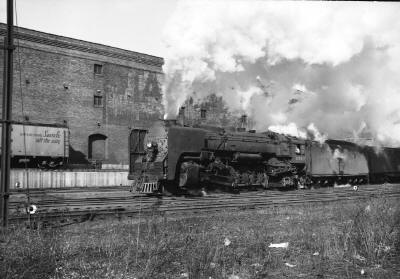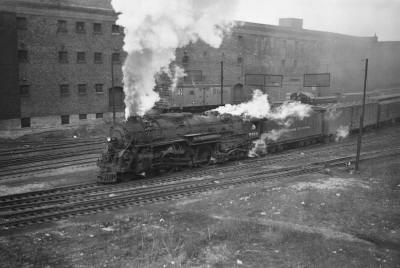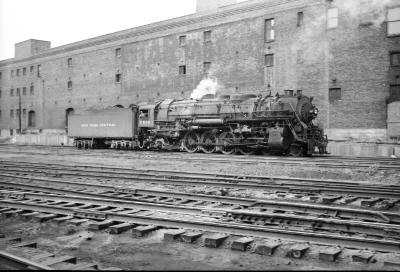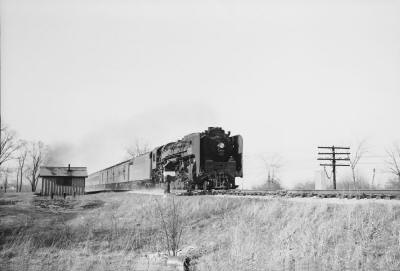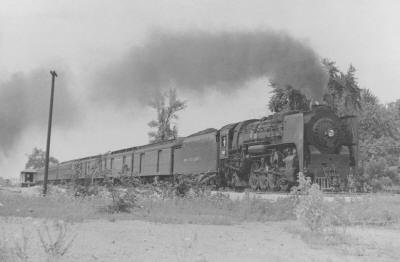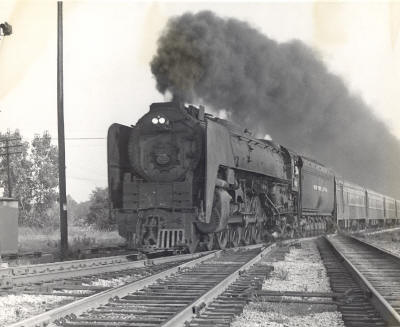|
New York Central Passenger Steam Engines
In the 1950s you would have seen three classes of NYC passenger steam engines in Columbus, the 4-6-4 Hudson, the 4-8-2 Mohawk and the big 4-8-4 Niagara. 275, class J1-3 Hudsons were built, all but ten, by the American Locomotive Works in Schenectady, New York between 1927 and 1938. They had 79" drivers and a starting traction force of 53,500 lbs (10,900 of which was from the booster). Eleven of the Hudsons were streamlined in 1938 for use on the New York - Chicago named trains such as the Twenty Century Limited. Hudsons were also used on the T&OC when it had passenger trains. The Hudsons were the most common passenger engines on the NYC from the 1930's to the end of steam in the mid 1950's. The class L Mohawks were built between 1916-1943. The early class L types were built as freight only engines. Starting in 1940 some L-3 and the L-4 engines were designed as dual service engines and used for heavier passenger trains especially for troop trains during World War II. There were 65 L-3 and 50 L-4 engines. Some were equipped with very distinctive smoke deflectors often referred to as elephant ears. The L-3 had 69" drivers and the L-4 had 72" drivers. Their starting traction force was approximately 60,000 lbs. There are two Mohawks preserved in museums, L-2d #2933 in St. Louis and L-3a #3001 in Elkhart, IN. There were only 27 class S Niagara engines. They were built in 1945 and 1946. Although reports stated that they were a superb engine they met a premature date with the scrap dealer due to dieselization. Once the Ohio State Limited was dieselized I don't think the Ohio Route had a need for an engine with the heft of a Niagara although I do have one picture below of a Niagara with the Cleveland Mercury. S class engines had 79" drivers and were rated at 6600 horsepower. They were capable of scooping water at 80 mph a sight I wish I had seen. The following pictures give some flavor to what was seen around Columbus in the early 1950's when the NYC ran 9-12 passenger trains a day. Cincinnati bound Mohawk #3125, possibility with the Cincinnati Special #433. Engine #3125 was a class L-4a built in 1943. This Cleveland - Cincinnati train would have been heavy with mail and express. It has just left Columbus Union Station. The Monypenny & Hammond Co. warehouse is in the background with a Santa Fe refrigerated box car at the loading platform. The back of the Columbus Union Station arcade that was on the west side of High Street is just visible behind the engine tender through the smoke. The photo was taken 3/21/1954 by DAK. The camera is looking northeast. This is the same train one month later, this time being pulled by Hudson #5350. Engine #5350 is a class J-1b built in 1927. The engine is about two engine lengths west of the location for the previous picture. The telltales over the tender were used to warn anyone riding on top of a box car of the low clearance ahead. Just west of this spot is the Front Street bridge and just east the High Street bridge. Either one could hurt a standing trainmen riding a box car. The photo was taken 4/25/1954 by DAK. The camera is looking northeast. Mohawk #2886 is backing from Union Station to the McKinley Avenue shops located west of Union Station. The warehouse in the background is the same building as the two previous photos. This Mohawk is class L-2c built in 1929 and does not have the smoke deflectors the newer 4-8-2's did. The engine will soon pass under Front Street. Its coal bin is only half full indicating it probably just came to Columbus from Cincinnati. The photo was taken 3/21/1954 by DAK. The camera is looking northwest. This Mohawk has just crossed Schrock Rd and is approaching Worthington, about ten miles north of Columbus Union Station. It would be going 70+ mph at this point. This is also the location of the north end the NYC's Worthington passing siding. The NYC was a single track line in this area and the siding gave a place for freights to hold up for the passenger trains. Occasionally if a passenger train was off schedule you might see one of them in the siding as well. The siding was controlled by the Worthington tower located about 1 1/2 miles south of this point. The small building was used by the NYC section crew to store their tools and motor car. The photo was taken June, 1955 by DAK. The camera is looking northeast. Another Mohawk at speed approaching the Worthington tower where the PRR two track Sandusky Branch crossed the NYC. The train is crossing the State Route 161 bridge which is difficult to see in the photo. It is located where you see the pole. This shot was taken about one mile south of the previous photo. You can see that the smoke deflectors are keeping the smoke away from the engine crew. The photo was taken in the early 1950's by BJK. The camera is looking northeast. Niagara #6020 is pulling the Cleveland Mercury northbound at Worthington. It is just crossing the Worthington interlock diamond where the double track PRR crosses the NYC. This interlock plant used almost all mechanical switch equipment with levers in the tower connected to the track switches with pipe. You can see some of those connectors in the foreground. It sometimes took two good arms for the tower man to move those levers. The Mercury equipment was very modern in 1935 when it was designed by industrial designer Henry Dreyfuss. Even in the 1950's it had a special streamlined look not seen on other standard trains through Columbus. The photo was taken in the early 1950's by BJK. The camera is looking southeast. |

